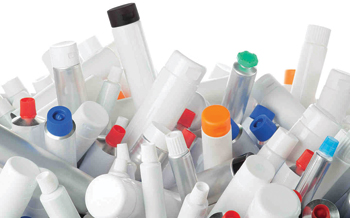Rigid plastic packaging
Figures, market and trends Production and use of rigid packaging. Focus on bottles, flacons, tubs, trays, bins, blisters, honeycombs, crates, pallets, flexible tubes and closures.
 After signs of recovery in 2010 - featuring a come-back on the period of crisis 2008/2009 - plastic packaging production has suffered a further setback due the further economic and market downturn. All told 2011 is estimated to have ended with a reaffirmation of the figures for 2010: mainly thanks to the positive trend in exports, which has persisted for all 12 months of the year, while domestic demand has shown a general decline of around 2%. As well as the general drop in consumption, the shrinkage of domestic demand is also due to the considerable decline in the use of plastic shopping bags.
After signs of recovery in 2010 - featuring a come-back on the period of crisis 2008/2009 - plastic packaging production has suffered a further setback due the further economic and market downturn. All told 2011 is estimated to have ended with a reaffirmation of the figures for 2010: mainly thanks to the positive trend in exports, which has persisted for all 12 months of the year, while domestic demand has shown a general decline of around 2%. As well as the general drop in consumption, the shrinkage of domestic demand is also due to the considerable decline in the use of plastic shopping bags.
The marketing of biodegradable shopping bags has not been a resounding success, especially in modern distribution, where it is estimated that their use has declined by about 30%.
The area of rigid packaging, object of this analysis, according to a preliminary assessment shows an output of 1,736,000 tons, accounting for around 58% of global production of plastic packaging, marking in 2011 an increase in production of 1.2% compared to 2010.
Approximately 80% of rigid plastic packaging produced is destined for the Italian market, while exports account for the remaining 20% of output, and show a positive growthrate.
Exports are particularly strong in two areas: closures (50%) and accessories (straps, adhesive tapes, protective material, etc. ... 35%).
There is also an import flow into Italy, covering on average 18% of domestic consumption, especially that of closures (around 30% of demand).
Since 2010 bottle preform imports, containing a portion of recycled PET, have seen a gradual increase,.
The use of recycled plastic in packaging production dates back several years: initially destined for the production of non-food packaging, after the lifting of the ban the use of recycled plastic in the food area is steadily increasing (although currently only a feature of imported products).
Types and areas of use
Rigid plastic packaging is applied in numerous sectors: in food (fresh and preserved), beverages, technical products etc. This type of packaging can be organized into four sub-areas: bottles for liquid food (29%), bottles, flacons and containers for various technical products (non food) 27.5%; honeycombs, blisters, trays and tubes 26.5%; closures and various accessories 17%. All four market areas, immediately after the recessionary effects of the period 2008/2009 and the general recovery in 2010, in 2011 were affected by the downturn experienced by the economy in the last quarter of the year. Last year also saw widespread tendency towards downgauging, ie the reduction in the average weight of packaging. With regard to the sectors of use of rigid plastic packaging the analysis can be made considering three areas: bottles and flasks; tubs, drums, crates, trays, flexible tubes etc..; closures and accessories.
Bottles and flacons. Their main outlet area are beverages (alcoholic and nonalcoholic) with a share of 65%, where mineral water and soft drinks in general (carbonated and non-carbonated) predominate.
The domestic cleaning sector is the second area of use, with a share of 12%, down on previous years: The drop is due to a reduction in the average weight of packaging in general, but also by the increased distribution of detergents in concentrated form, which require smaller containers, as well as less purchases. Other interesting areas of use include food oil and milk, with a global share of 10%, the cosmetic pharmaceutical area with a share of 8% and, again, pureed tomatoes, wine and vinegar, with a global share that currently stands at 5%.
Closures and accessories. This segment is estimated to have grown by 4% in 2011. Exports, that cover around 70% of output, in fact constitute the real growth driver. As regards the domestic market a progressive increase is particularly seen in the spirits segment.
Sundry rigid containers. Trays, tubs, crates, pallets, flexible tubes, blisters etc.: estimates show that

78% of these items are absorbed by the food macro sector, the remaining 22% by non food (still referring to the sector sample monitored by the I.I.I.).
Thin-wall packaging (cups, trays, beakers, blisters etc..) is the category that potentially shows the greatest growthrate.
The success of this type of packaging originates primarily from the increase of pre-weighed portions food items and ready made meals on the cold shelf, which are gaining hold in the largescale retail trade (LRT) but also with traditional retailers.
Likewise blisters show an interesting growth potential, created to pack pharmaceuticals and cosmetics, they have also gained hold in computer accessories, stationery and smallware.
Interesting the presence of the plastic crate, both disposable and returnable, in the field of fresh produce as transport packaging (approximately 50%): in particular returnable crates are showing substantial and progressive growth.
Plinio Iascone
Istituto Italiano Imballaggio



















